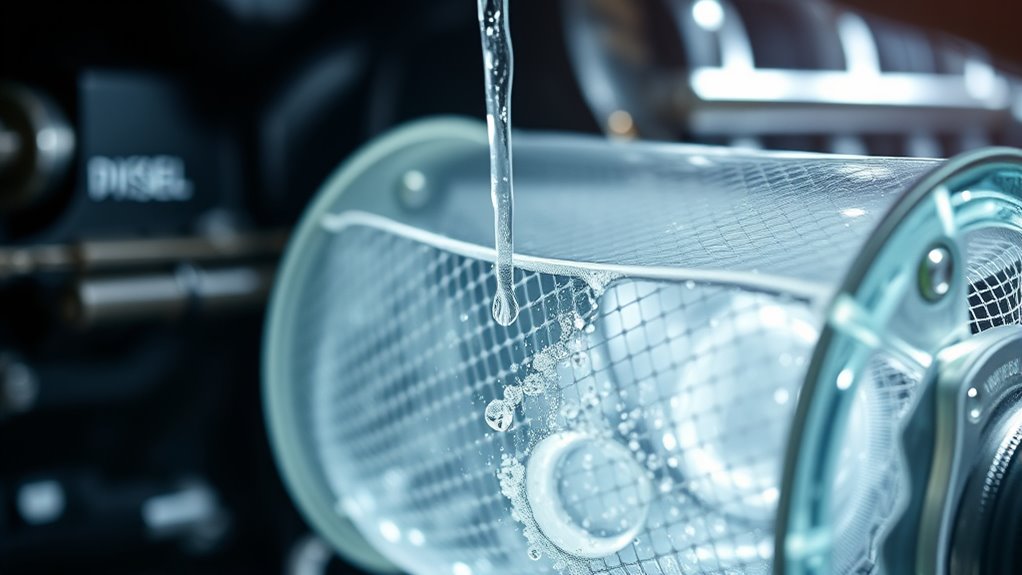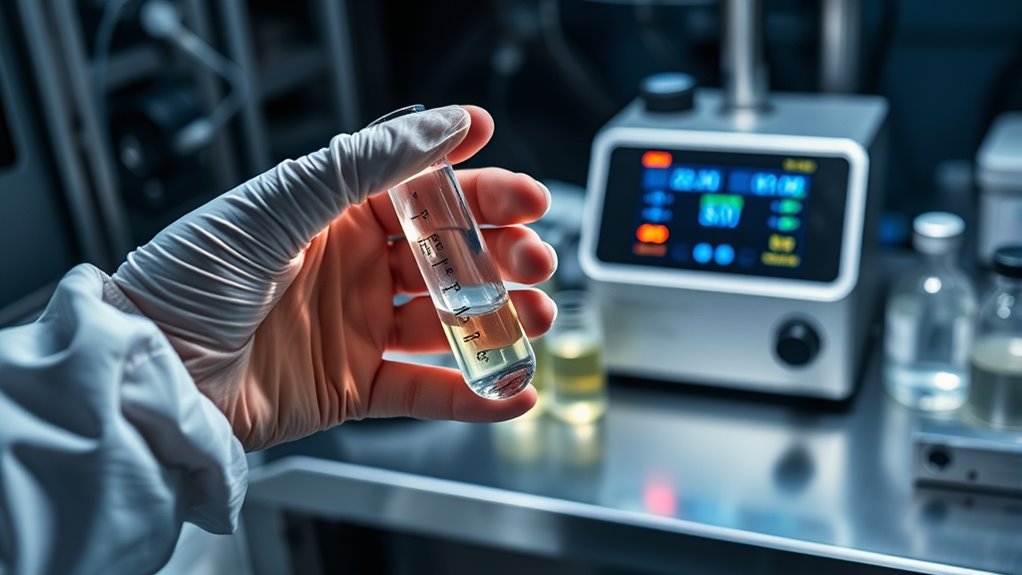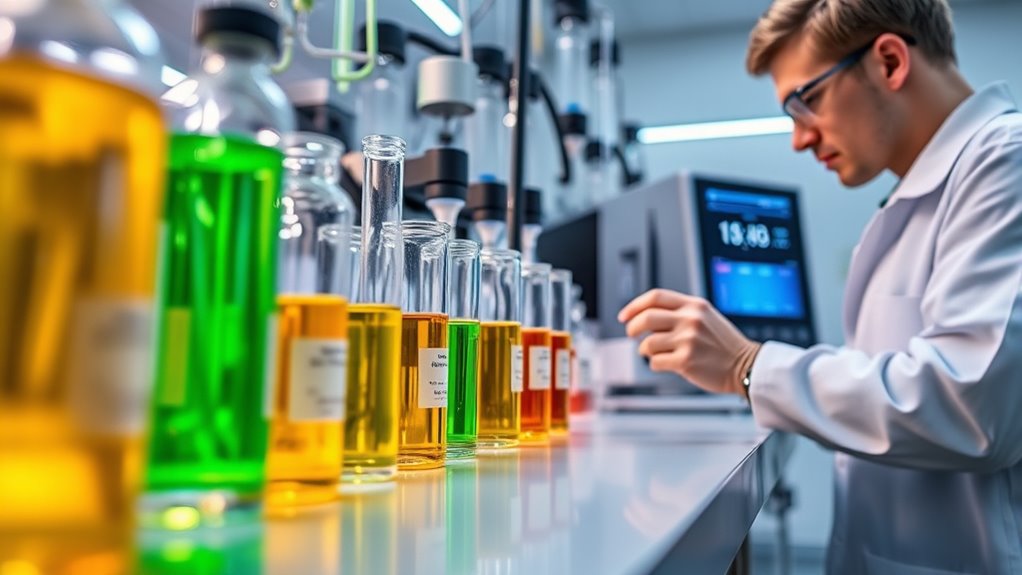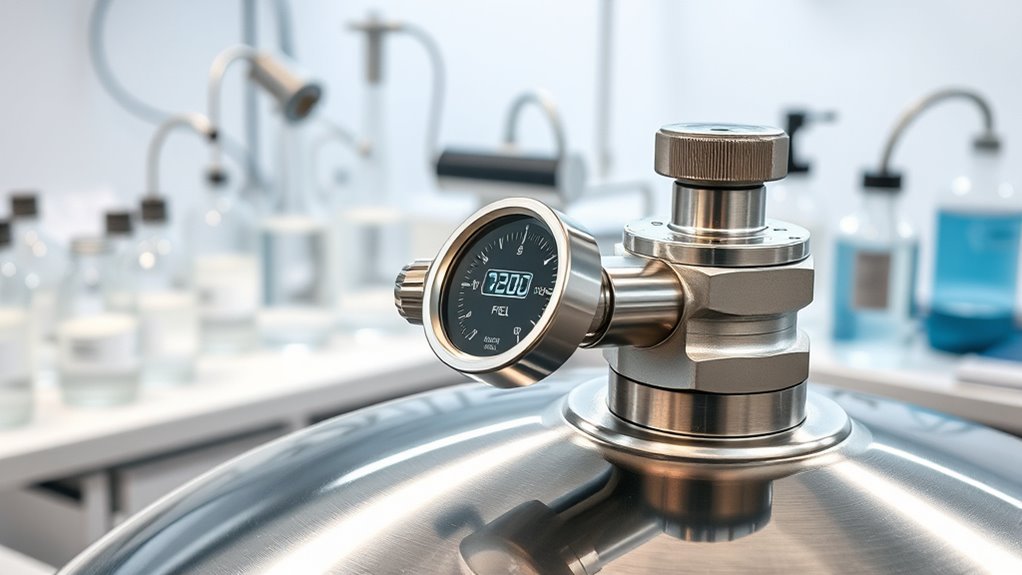To keep your fuel clean and safe, follow strict storage and handling practices, use quality-tested additives, and regularly inspect for contamination signs like discoloration or water. Guarantee compliance with fuel standards and regulations, including proper sampling and online monitoring. Recognize fraud and adulteration early with simple on-site tools. Staying vigilant and understanding fuel properties helps prevent engine damage and costly repairs. Keep going to uncover more essential tips for ensuring premier fuel quality and contamination prevention.
Key Takeaways
- Regularly inspect and test fuels for contaminants using visual checks, chemical analysis, and portable sensors.
- Store fuels properly in corrosion-resistant tanks, away from water, extreme temperatures, and ignition sources.
- Use certified additives and maintain consistent fuel formulations to prevent engine deposits and performance issues.
- Follow strict regulations and standards (ISO, ASTM, EPA) to ensure fuel purity, proper properties, and environmental compliance.
- Implement real-time monitoring of storage and dispensing systems with sensors and leak detection technologies to prevent contamination.
Understanding Fuel Quality Standards and Regulations

Understanding fuel quality standards and regulations is essential because these rules guarantee fuels are safe, environmentally friendly, and compatible with vehicles across different regions. In the EU, strict criteria limit pollutants like sulphur oxides, benzene, and particulate matter, helping protect health and the environment. They also cap biodiesel (FAME) at 7% and ethanol at 10% to ensure engine compatibility. The goal is to create a seamless single fuel market where vehicles operate uniformly across borders. In the U.S., federal standards focus on reducing emissions through regulations like low sulfur diesel and oxygenated gasoline in smog-prone areas. Many states, such as Texas and Ohio, add local rules to address specific environmental and safety needs. These regulations work together to promote cleaner, safer fuels and maintain vehicle performance nationwide. Additionally, automated security protocols in fuel testing and certification processes help ensure compliance with these standards efficiently.
Key Fuel Components and Their Impact on Engine Performance

The chemical makeup of fuel components directly influences engine performance by affecting combustion, power output, and efficiency. Hydrocarbon chains determine volatility and energy content, impacting how well your engine runs. Adding oxygenates like ethanol improves combustion but can harm engine parts and cause water phase separation. Trace metals and acids can corrode fuel system components, reducing reliability. Fuel additives such as detergents keep injectors clean, supporting ideal combustion. The use of cybersecurity measures in fuel management systems helps prevent malicious tampering and data breaches that could disrupt operations. Future biofuels with ketones and other compounds may alter combustion stability and emissions. The octane rating affects knocking resistance, while volatility influences cold starts and idling. Properly formulated fuel ensures efficient burning, protects engine parts, and maintains smooth performance. Proper formulation of fuel is essential to prevent the buildup of harmful deposits and ensure consistent engine operation. Avoiding contaminants and using quality fuel components are essential for engine longevity and ideal operation.
Recognizing and Preventing Fuel Contamination

Fuel contamination can silently degrade your fuel quality and cause costly equipment issues if left unchecked. To prevent this, you need to recognize early signs of contamination and implement proper measures.
- Conduct regular visual inspections for discoloration, cloudiness, or sediment in your fuel.
- Use water detection paste on tank probes to identify water layers, which often originate from condensation or ingress.
- Sample fuel from tank bottoms periodically, especially in humid environments, and analyze it for microbial growth, particulates, or chemical anomalies. Regular testing can help detect fuel quality issues before they lead to significant problems.
Storing fuel properly—keeping tanks full, in shaded areas, and using dedicated, clean transfer equipment—reduces contamination risks. Consistent monitoring and prompt action keep your fuel system clean and efficient, avoiding costly repairs and downtime.
The Role of Storage and Handling in Maintaining Fuel Integrity

Proper storage and handling are essential to maintaining fuel integrity and preventing contamination. You should choose corrosion-resistant, leak-proof tanks made of steel, aluminum, or HDPE, ensuring they meet local regulations and are designed for your fuel type. Proper placement in cool, shaded areas away from sunlight, ignition sources, and water-prone zones reduces risks. Use containment barriers and insulate or bury tanks in extreme climates to prevent moisture and temperature-related issues. Regular inspections for corrosion, leaks, and seal integrity are crucial, along with monitoring systems that detect early contamination. Proper handling also involves storing fuel in approved containers, providing safety equipment, and training personnel. The following table illustrates ideal storage considerations:
| Storage Consideration | Best Practice |
|---|---|
| Tank Material | Steel, aluminum, HDPE |
| Placement | Shaded, away from water and ignition sources |
| Environmental Controls | Insulation, berms, ventilation |
| Maintenance & Inspection | Routine checks, leak detection, cleaning |
Additionally, maintaining appropriate ventilation around storage areas helps prevent the buildup of dangerous fumes and reduces the risk of fire hazards.
Monitoring and Detecting Fuel Fraud and Adulteration

To safeguard your fuel from fraud and adulteration, you need effective monitoring methods. You can use technology to identify common scams like siphoning, card skimming, and unauthorized refueling. Regular testing for contaminants and inspecting dispensers help guarantee fuel quality remains uncompromised. Fuel theft causes global losses of up to $133 billion annually, underscoring the importance of vigilant monitoring to protect your assets. Implementing quality control measures can further enhance detection accuracy and prevent potential financial losses.
Identifying Common Frauds
How can you effectively detect and monitor fuel fraud and adulteration before significant losses occur? Being alert to common fraud indicators helps you catch issues early. Here are key signs to watch for:
- Discrepancies between reported mileage and odometer readings, indicating possible fuel theft or tampering. Fuel level anomalies can often be linked to tampering or siphoning activities. Regularly inspecting fuel tanks and recording fuel levels can help identify suspicious drops.
- Fuel receipts showing volumes that exceed vehicle tank capacity, suggesting fraudulent transactions.
- Unusual MPG readings or off-route fueling, which may point to adulteration or unauthorized activity.
Using fuel sensors, GPS data, and real-time analytics, you can identify sudden drops in fuel levels or irregular fueling patterns. Cross-verifying transactions with vehicle behavior and GPS routes enables quick detection of suspicious activities, reducing losses and ensuring fuel integrity. Employing monitoring tools that analyze fuel consumption patterns enhances early detection efforts.
Testing for Adulterants
Detecting fuel adulteration early helps prevent significant losses and maintains fuel integrity. Laboratory techniques like gas chromatography and infrared spectroscopy offer high precision in identifying adulterants, but they require skilled technicians and lab setups. Chemical analysis can detect trace contaminants through specific reactions or compositional differences. Tests such as ASTM D3810 evaporation and ASTM D86 distillation identify low-level adulteration, though they are mainly lab-bound. Portable sensor-based systems, like Arduino with MQ2 gas sensors, enable real-time, on-site detection of adulterants such as paraffin and methanol, providing quick results within seconds. Physical property tests, including density measurements, filter paper residue, and flash point analysis, help spot contamination in the field. These methods, combined with electromagnetic and ultrasonic techniques, deliver fast, reliable detection, safeguarding fuel quality efficiently. Additionally, understanding the trustworthiness of detection methods is crucial to ensure accurate results and avoid False positives or negatives.
Monitoring Dispenser Integrity
Monitoring dispenser integrity is essential for preventing fuel fraud and ensuring accurate transactions. You need reliable systems to detect tampering, leaks, or adulteration early. Here are three key methods:
- Sensor Technologies: Magnetostrictive sensors quickly identify water in containment sumps, while flow meter displacement sensors verify fuel flow and detect tampering. Wireless transponder systems monitor sensor signals, alerting you if sensors are removed or signals deviate. These sensors are designed to operate reliably in harsh environments, ensuring continuous monitoring without false alarms. Additionally, incorporating juice extraction principles can enhance fuel sampling accuracy by ensuring consistent flow and measurement, reducing the chance of errors or manipulation.
- Leak Detection: Vacuum sensors and ALLD systems continuously check for leaks or system breaches, activating alarms and preventing unnoticed failures.
- Mechanical Monitoring: Sensors track nozzle shutoffs, pump shaft rotations, and key mechanical events to confirm proper operation and flag any anomalies, ensuring measurement accuracy and fraud prevention.
Regulatory Compliance for Fuel Suppliers and Dispensers

Ensuring regulatory compliance is essential for fuel suppliers and dispensers to operate legally and maintain market integrity. You must obtain and renew licenses from local, state, and federal authorities, guaranteeing your operations meet all registration requirements. Fuel and additive products, like gasoline and diesel, need to be registered under Title 40 CFR Part 79, unless exempted under statutes like TSCA. As an importer, you’re considered a manufacturer and must fulfill registration and reporting obligations. Environmental compliance is also critical; you must adhere to programs like California’s LCFS and report GHG emissions if your fuel volumes exceed thresholds. Regular audits, real-time monitoring, and third-party verification help assure data accuracy. Maintaining compliance protects your business, supports environmental goals, and safeguards market trust. Utilizing sound recording techniques and proper equipment can further enhance the quality and reliability of your fuel testing processes.
Embracing Alternative Fuels and Ensuring Their Quality

As you adopt alternative fuels, it’s crucial to follow strict quality assurance measures to prevent contamination and guarantee optimal performance. Standards from organizations like ISO and ASTM set clear guidelines for fuel purity, contaminants, and performance metrics. By prioritizing these standards, you can maintain vehicle efficiency and comply with regulatory requirements effectively. Consistency in fuel quality is essential to prevent engine issues and extend vehicle lifespan, making adherence to these standards an integral part of fuel management. Implementing advanced testing methods can further ensure the detection of potential contaminants before they affect operations.
Standards for Alternative Fuels
Establishing clear standards for alternative fuels is essential to guarantee their quality, safety, and performance across different regions and vehicle types. Regulatory bodies set specific requirements to prevent contamination and ensure compatibility. Here are key points to consider:
- Regional Regulations: State authorities, like New York and California, enforce fuel specifications, testing methods, and retrofit standards to maintain quality.
- Federal Standards: The EPA’s Renewable Fuel Standard (RFS) establishes nationwide volume targets and lifecycle greenhouse gas reduction criteria for renewable fuels.
- Fuel Property Specifications: Standards address purity, energy content, contaminant limits, and stability, ensuring fuels meet performance needs and prevent engine issues.
Following these standards helps protect your vehicles and supports the growth of a sustainable alternative fuels market.
Quality Assurance Measures
Maintaining high fuel quality across the supply chain requires rigorous sampling and testing at various stages, from refineries and import terminals to retail stations. You should implement systematic sampling protocols, including mechanical systems and online analyzers, to verify fuel parameters like chemical composition, moisture, and ash content in real time. Independent laboratory testing, alongside industry self-monitoring, confirms fuel authenticity and compliance. Rapid on-site analysis near production or use points allows swift corrective actions, reducing risks. Ensuring adherence to specific quality standards for alternative fuels—such as ethanol, biodiesel, or renewable diesel—is essential. Industry partnerships with dedicated testing providers help mitigate risks and maintain supply chain integrity. Strong verification processes and enforcement policies hold producers accountable, safeguarding performance, emissions standards, and environmental health. Additionally, implementing proper fuel blending techniques can prevent contamination and ensure consistent fuel quality throughout distribution.
Frequently Asked Questions
How Often Should Fuel Quality Testing Be Conducted at Retail Stations?
You should have fuel quality tested at retail stations at least once a year to guarantee compliance with safety and quality standards. If issues are found during inspections, testing frequency may increase to every six months or more. Regular, unannounced visits and sampling help catch problems early, protect consumers, and maintain regulatory compliance, so staying proactive with testing schedules is the best way to ensure fuel quality and station integrity.
What Are the Common Signs of Contaminated Fuel in Vehicles?
You’ll notice contaminated fuel if your vehicle’s engine stalls, sputters, or idles roughly. Watch for loss of acceleration, poor fuel efficiency, or engine jerking under load. Unusual fuel odors, hazy or dark fuel, and visible sludge in the tank are clear signs. Dashboard alerts like “Check Engine” lights and abnormal exhaust smoke also indicate fuel contamination, prompting you to inspect and possibly replace filters or clean the tank.
How Can Consumers Verify Fuel Quality at the Pump?
You can verify fuel quality at the pump by inspecting its clarity and smell—look for discoloration or strange odors that signal contamination. Check the dispenser for certification seals and cleanliness. Use portable test kits to detect water, sediments, or microbial presence. Listen for unusual pump noises, monitor engine performance for rough idling or power loss, and ensure your vehicle’s diagnostics show normal fuel pressure. Trust reputable suppliers committed to quality standards for added peace of mind.
Are There Specific Storage Practices for Biofuels to Prevent Degradation?
To prevent biofuel degradation, store biodiesel, ethanol, and HVO in climate-controlled environments, keeping temperatures above their cloud point or crystallization point. Use compatible, sealed tanks made from stainless steel, aluminum, or fiberglass, and regularly inspect and drain water to avoid microbial growth. Insulate and heat tanks as needed, and guarantee proper sealing to prevent oxygen, light, and moisture exposure, maintaining fuel stability and quality over time.
What Are the Penalties for Non-Compliance With Fuel Quality Standards?
If you don’t comply with fuel quality standards, you risk hefty fines, criminal charges, and damage to your reputation. In the UK, courts can impose unlimited fines under the Clean Air Act, while in the US, the EPA can fine up to $37,500 daily per violation. Penalties also increase with violations, like exceeding benzene limits or failing fuel economy standards, potentially costing millions if left uncorrected.
Conclusion
By understanding fuel quality and contamination prevention, you can keep your engine running smoothly, much like a well-tuned symphony. Think of clean, quality fuel as the steady heartbeat beneath a busy city—unseen but essential. When you handle, store, and choose fuel wisely, you create a seamless flow that keeps your journey moving forward. Remember, just as water finds its way through cracks, consistent care ensures your fuel remains pure and performance stays at its peak.









